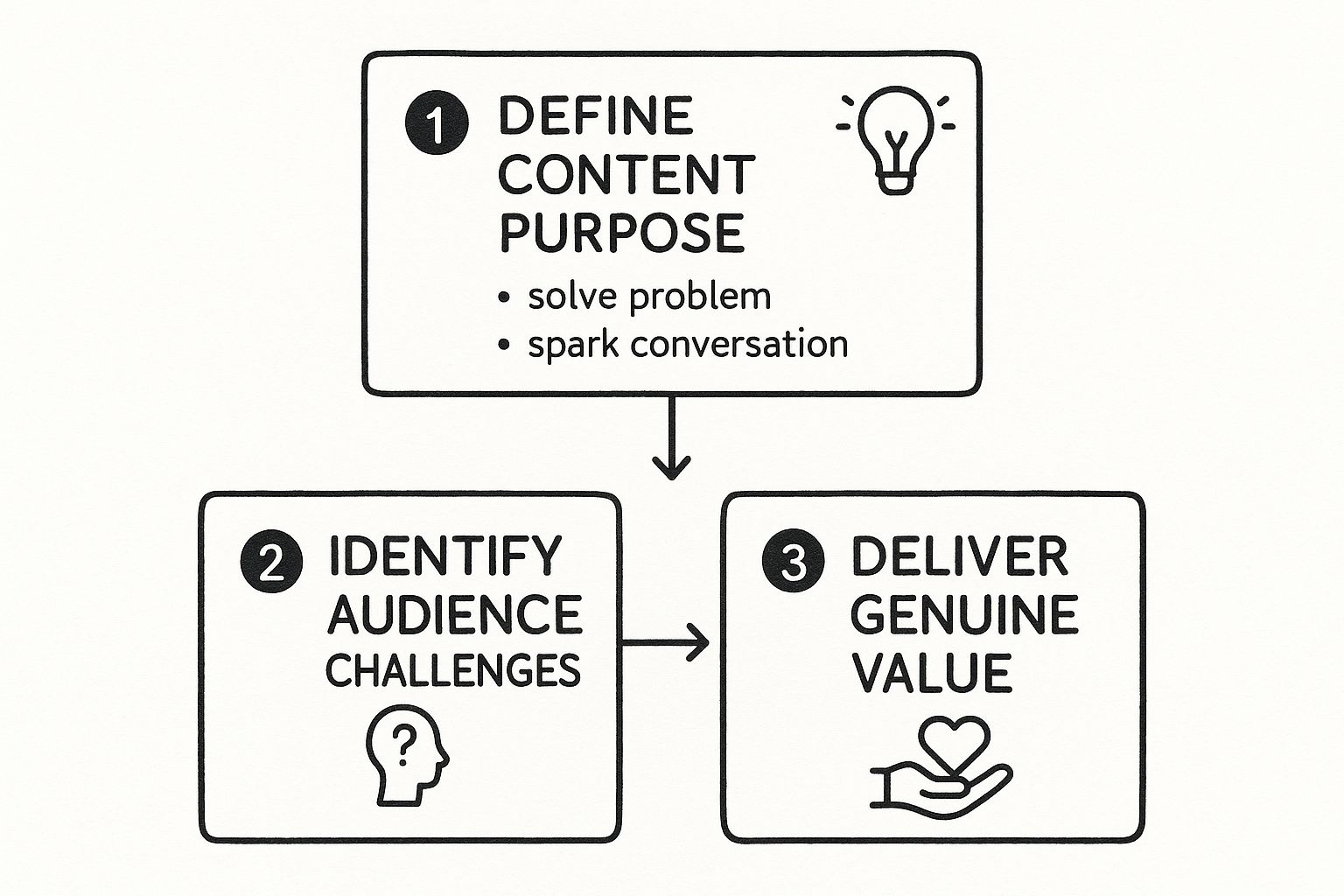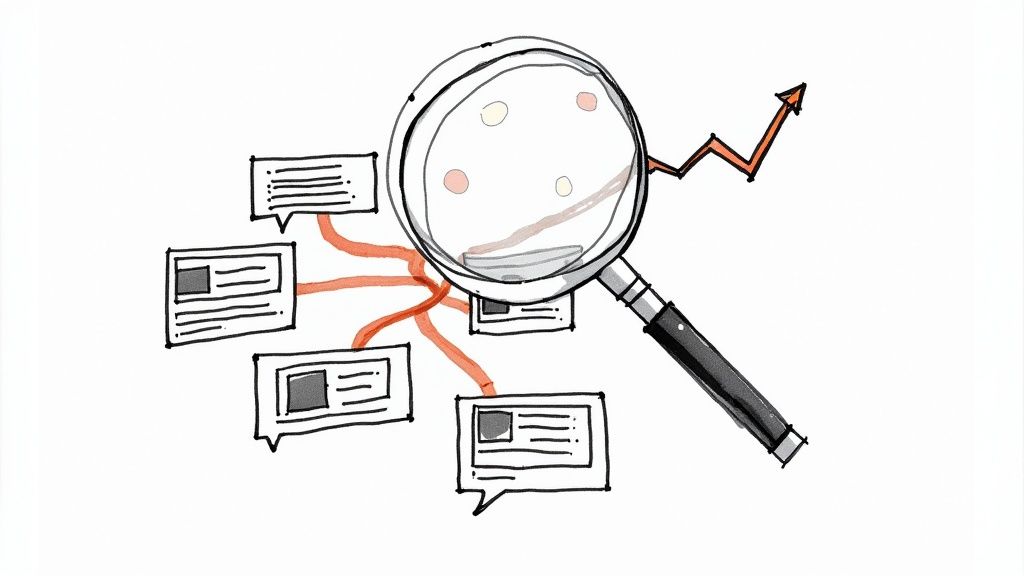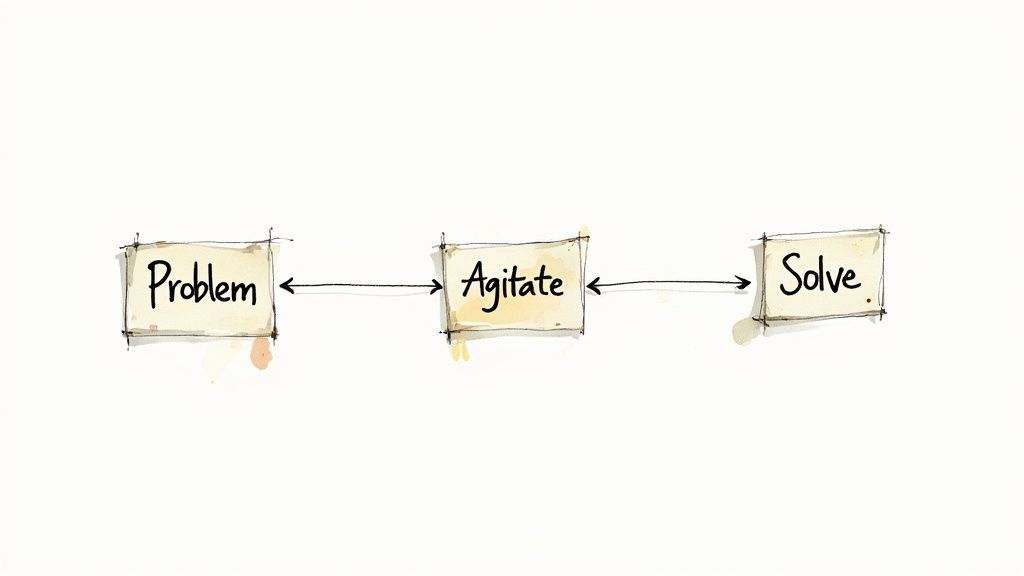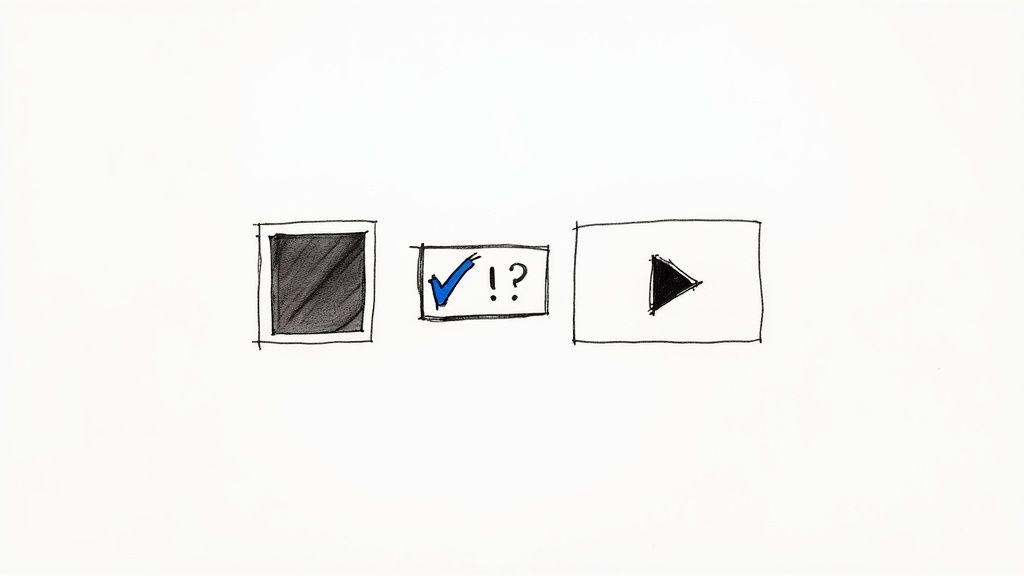October 12, 2025

To create content that genuinely connects, you need to anchor your strategy in three core principles: define a clear purpose, deeply understand your audience's challenges, and deliver undeniable value. This means shifting your entire mindset from what you want to say to what your audience truly needs to hear.
First things first, let's get one thing straight: "engaging" is not the same as "viral." Sure, a massive spike in likes and shares feels incredible, but true engagement is about forging a real connection. It’s about making your audience feel seen, understood, and motivated to take the next step.
You're aiming for something deeper than a fleeting moment of attention. The goal is to build a loyal following that genuinely trusts your perspective.
Engaging content doesn't just broadcast information; it solves a specific problem, offers a unique point of view, or starts a conversation worth having. The secret sauce isn't a slick design or a clickbait-y headline—it's empathy. It all comes down to digging into the real-world frustrations your audience grapples with and creating something that serves as a direct solution.
Before you even start outlining, you have to ask one crucial question: What is the primary goal of this piece of content? Without a clear purpose, your content will feel lost and unfocused. Every great piece of content should aim to do at least one of these things:
If you want to see this in action, take a look at these powerful community engagement examples. You'll notice that every successful initiative starts with a crystal-clear goal.
This simple process flow visualizes how to build content that truly connects.

This visual drives home the point that providing value isn't a happy accident—it’s the result of a deliberate, thoughtful process.
The best content creators I know are exceptional listeners. They don't just guess what their audience wants; they invest real time into understanding their pain points. This means going way beyond surface-level demographics and digging into the psychological triggers behind their actions and decisions.
Think about this: consumers are 54% more likely to purchase from creators they find relatable. That single statistic highlights the immense power of building an authentic connection.
The core of creating engaging content is simple: stop talking at your audience and start a conversation with them. True engagement happens when your content becomes a trusted resource in their professional journey.
This requires a fundamental shift in your approach. For example, instead of a generic guide on "event planning," you could create something far more specific and valuable like, "How to Manage Last-Minute Speaker Cancellations." That’s a real, high-stress problem that event organizers actually lose sleep over.
To really nail this, it helps to study online course design strategies for engagement, because course creators are masters at turning passive observers into active participants. This is the foundation upon which all truly memorable content is built.
To make this even clearer, I've broken down the essential elements into what I call the "Four Pillars." Think of this table as your quick-reference guide for transforming standard content into something that truly resonates.
By keeping these four pillars in mind, you ensure every piece of content you create is built on a solid foundation of audience understanding and a commitment to providing real, tangible value.

Great content isn't just created; it's uncovered. The best ideas come directly from the real needs, burning questions, and daily frustrations of your audience. The most successful creators I know are expert listeners first and creators second. They look past simple demographics to truly understand what keeps their community members up at night.
This is how you stop guessing and start creating content that has a built-in audience. It’s a simple but powerful shift in thinking. Instead of asking, "What should I post today?" start asking, "What does my audience need from me today?" The answers are almost always hiding in plain sight.
Digital hangouts like Reddit, niche LinkedIn groups, or even the comment sections on industry blogs are absolute goldmines. These are places where people get real. They ask candid questions, vent about their biggest headaches, and share the clever workarounds they've discovered.
Think of these platforms as massive, always-on focus groups. Let’s say you run a community for event planners. You might stumble upon a Reddit thread where dozens of people are commiserating over the nightmare of keeping virtual attendees engaged. That isn’t just one content idea; that’s an entire content pillar waiting for you to build on.
As you dig in, keep an eye out for:
By immersing yourself in these conversations, you build a deep, genuine understanding of your audience’s world. That’s the foundation for everything. If you want to take it a step further, check out our guide on how to build an online community to create a space where these conversations can happen on your own turf.
Your competitors have already done some of the heavy lifting. Analyzing what they’re putting out isn’t about copying them—it’s about spotting what they’re missing. Look at their most popular articles, videos, and social posts. What topics get the most comments, shares, and conversations?
Then, put on your detective hat and ask some key questions:
For example, a competitor might have a popular but vague article on "The Importance of Networking." You can swoop in and create something far more valuable by getting specific, like "A Script for Re-engaging Cold Contacts Without Being Awkward." This hones in on a real pain point that the broader topic glosses over.
Your best content ideas often live in the gap between what your audience is asking for and what your competitors are providing. Your job is to find and fill that gap with undeniable value.
You don't always need fancy tools. Just manually monitoring relevant hashtags and keywords can help you tap into real-time conversations and emerging trends. What are the industry leaders buzzing about right now? What new challenges have popped up that nobody has tackled yet?
This approach is all about being timely. When a new technology shakes up an industry or a new regulation is announced, people scramble for clear, trustworthy information. If you can be one of the first to provide a thoughtful, well-researched perspective, you can quickly become a go-to resource.
Imagine you manage a community for professional associations and notice a sudden spike in chatter around "AI for member engagement." That’s your signal. It's time to create content that demystifies the topic, like:
When you start using these discovery methods—digging through forums, analyzing competitors, and listening to social chatter—you build a repeatable system for generating fantastic ideas. You move from guesswork to a solid strategy, ensuring every piece of content you create is something your audience genuinely wants and needs. That's the secret to not just getting attention, but actually keeping it.

Once you've landed on that brilliant, audience-focused idea, the real work begins. Raw information, data, and facts are just the building blocks; they aren't the house. To create something truly engaging, you have to transform those raw materials into a story that grabs attention and actually sticks in your audience's memory.
Let's face it, people are wired for narrative. A well-told story can make a complex idea feel simple and an abstract concept feel personal. It’s the difference between just listing features and showing how a product genuinely changed someone’s workday for the better. This is where you learn to make your content not just informative, but unforgettable.
You don’t need to reinvent the wheel here. Certain narrative structures have worked for centuries because they tap directly into human psychology. One of the most effective and adaptable formulas for content creation is Problem-Agitate-Solve (PAS).
It's beautifully simple:
For instance, a blog post for community managers could put PAS to work like this:
This structure hooks the reader immediately by validating their struggle before offering a clear path forward.
Your headline is the single most important part of your content. Full stop. It's the gateway, and if it fails, even the most brilliant article will go unread. The goal isn't to write clickbait, but to create a headline that is clear, intriguing, and accurately promises value.
Think of it as the subject line of an email you can't wait to open. Online, readers typically only read about 20% of the text on a page, so your title has to do some serious heavy lifting to pull them in.
Your headline makes a promise. The rest of your content must deliver on that promise. A great headline with mediocre content breaks trust, while a mediocre headline for great content wastes potential.
Here are a few proven approaches for writing better headlines:
Once someone clicks, the battle for their attention continues. The structure of your content is just as crucial as the words themselves. Walls of text are a massive turn-off and will cause readers to hit the back button instantly. Your job is to create a scannable, inviting reading experience.
We process visuals 60,000 times faster than text, and this principle applies to the visual structure of your writing. Ample white space, short paragraphs, and clear headings act as signposts, guiding the reader smoothly through your ideas.
To make your content a breeze to scan:
Finally, the most engaging content always feels like it was written by a real person, not a faceless corporation. Your brand voice is the personality that shines through your writing. Are you helpful and authoritative? Witty and informal? Inspiring and empathetic?
There isn't a single "right" voice. The key is to be consistent and authentic to your brand and your audience. An authentic voice builds trust and fosters a genuine connection, making your audience feel like they're part of a real conversation.

Let's be honest: in a world of endless scrolling, text just doesn't cut it anymore. If you want your content to stop someone in their tracks, it has to be visually interesting and, ideally, interactive. This isn't about window dressing; it's about making complex ideas stick and turning passive readers into active participants.
Think about it—our brains process images an incredible 60,000 times faster than text. By weaving in the right visual and interactive elements, you're not just creating content. You're crafting an experience.
We've all seen them—the same generic stock photos of smiling people in boardrooms. While high-quality stock images can work in a pinch, custom visuals signal to your audience that you’ve put real thought and effort into what you've created. It instantly adds a layer of authority.
Instead of defaulting to the usual, try these high-impact alternatives:
Video isn't a "nice-to-have" anymore; it's a core part of any serious content plan. Social media is where the action is, and video is what drives that action. Consider that 78% of people prefer to learn about a product through video, and it's no surprise that 93% of marketers are planning to invest more in social marketing videos.
You don't need a massive production budget to make an impact. Short-form video, in particular, is accessible for just about anyone and incredibly effective.
The most engaging videos are often the most authentic. A simple, well-lit smartphone video that solves a specific problem can be far more powerful than a slick, overproduced ad that feels impersonal.
Look at the content you've already written. A list-based blog post can be quickly repurposed into a punchy, engaging video for TikTok or Instagram Reels. For more practical tips, our deep dive on training video creation has actionable advice that you can apply to almost any kind of instructional video.
Interactive content works so well because it requires the user to do something. That simple act of participation flips the switch from passive consumption to active involvement. The result? They spend more time with your content and your brand.
It’s the difference between being lectured at and being part of a conversation. Here are a few straightforward ways to get started:
When you start blending compelling visuals with these kinds of interactive moments, you create a far more dynamic and memorable experience. You're not just trying to get eyeballs; you're building a loyal community that actually looks forward to what you'll create next.
Creating a brilliant piece of content is a huge win, but it's only half the job. The other, arguably more critical, half is making sure it actually reaches the people it was made for. The old "publish and pray" strategy just doesn't cut it anymore. If you want to really learn how to create engaging content that makes a difference, you need a smart, multi-channel distribution plan baked in from the start.
This means thinking beyond just hitting "publish" on your blog and hoping for the best. A solid plan is what turns your hard work into tangible results, helping you reach, engage, and grow your audience.
The most durable way for people to find your work is through a good old-fashioned search. When someone is actively looking for a solution you offer, they're already warmed up and ready to listen. Basic search engine optimization (SEO) isn't some dark art for tech wizards; it's a core part of creating content that gets found.
It all starts with getting inside your audience's head. What are they actually typing into Google? A little keyword research helps you find the exact phrases and questions they're using. From there, you can naturally weave those terms into your headlines, subheadings, and paragraphs. The goal isn't to stuff keywords in—it's to speak the same language as your audience.
Don't forget to structure your content for easy reading. Clear headings (H2s and H3s), short paragraphs, and bullet points are your best friends. This approach doesn't just help a human reader scan for what they need; it also gives search engines clear signposts to understand your content's structure and main ideas.
Your email list and social media followers are your direct connection to your community. These are people who've already given you a thumbs-up and said they want to hear from you. Make sure you treat them like the VIPs they are.
When you publish something new, your email subscribers should be the very first to find out. Write an email that does more than just drop a link. Tell them why this piece is valuable and how it helps solve a problem they're dealing with.
On social media, you have to play to each platform's strengths:
Looking for a shortcut to a bigger audience? Partner up with other creators or organizations in your field. This gives you an introduction to a brand new, relevant audience that already trusts the person you're working with.
This doesn’t have to be some massive, formal undertaking. It could be as simple as co-hosting a webinar, jumping on someone’s podcast as a guest, or even just quoting an expert in your article and giving them a heads-up. These collaborations create value for everyone involved—their audience gets a fresh perspective, and you get new exposure.
The power of creator marketing is undeniable. It's built on trust and authenticity, allowing brands to connect with audiences in a way that traditional advertising simply can't match.
The growth here has been nothing short of explosive. Since 2021, brands have cranked up their spending on creator marketing by a staggering 143%. And for good reason: a huge 70% of brands say their highest ROI campaigns have come directly from these kinds of partnerships. You can discover more insights about the creator economy and see for yourself how it's reshaping modern marketing.
You’ve done the hard work of creating the content. Now comes the part where real growth happens: figuring out what actually landed with your audience. To create work that consistently connects, you need a way to measure what resonates.
This isn't about chasing vanity metrics like raw page views or a flurry of likes. It's about digging deeper to find the signals of genuine connection and using those insights to get smarter with every piece you publish.
Think of it as a simple feedback loop: you create, you measure, you learn, and then you apply those lessons to what you make next. This is how you move from guesswork to a data-backed strategy that helps you deliver more of what your community truly wants.
It's so easy to get caught up in big, flashy numbers. But a post that gets 10,000 views is a complete dud if no one reads past the first paragraph. I'd much rather have a piece with 500 dedicated readers who spend several minutes absorbing the material and leaving thoughtful comments. Real engagement lives in the details.
Instead of getting distracted by surface-level data, start prioritizing metrics that show a real connection is being made.
Shifting your focus to these metrics gives you a much clearer picture of what's working and what isn't. For a deeper dive, our guide on social media engagement metrics can help you pinpoint the numbers that matter most for your community.
Once you start tracking these more meaningful KPIs, you’ll begin to see patterns. You might notice your case studies have an average time on page that's 70% higher than your listicles, or that posts with custom infographics get shared twice as often. This is where the magic happens.
Don’t just collect data—interrogate it. Ask why one piece of content completely outshined another. Was it the format? The headline? The storytelling? The answer is your roadmap for what to create next.
This is how you start making smarter, more confident decisions. If you see that your short video tutorials are driving the most engagement, that’s a clear signal to double down on them. If a certain topic consistently sparks thoughtful discussion, it's time to explore it from new angles. To truly see the big picture, you have to measure SEO success beyond rankings and focus on what's having a real business impact.
A simple but incredibly effective way to keep improving is with A/B testing. Never settle for your first headline idea; write two and see which one pulls people in. Try different calls-to-action to see what language gets your audience to act. These small, consistent tests add up over time, dramatically improving your ability to create content that hits the mark, every time.
Got questions? I've got answers. Here are a few common things people ask when they start focusing on creating more engaging content.
This is the big one, isn't it? While you might get lucky with an early win that brings a spike in engagement, real, sustainable results take time. You're building a relationship with an audience, after all.
Expect it to take a solid 3-6 months of consistent, high-quality content before you see a significant lift in audience loyalty and SEO rankings. The goal isn't just one viral hit; it's to build a library of genuinely helpful resources that becomes a go-to for your community.
Think of it like this: Engagement is a marathon, not a sprint. Consistent value will always win out over a one-off attempt to go viral. Build the foundation, and the audience will come.
You don't need a Hollywood budget to create stunning visuals. There are some incredible tools out there that can make a huge difference.
For Graphics & Simple Video: If you're just starting or need to work fast, Canva and Adobe Express are your best friends. They are packed with templates and are incredibly user-friendly.
For More Advanced Video: When you're ready to level up your video editing without paying a fortune, check out CapCut (amazing for mobile and desktop) or DaVinci Resolve. Both offer powerful, professional-grade features for free.
For Interactive Content: Want to really pull people in? Interactive tools are fantastic. You can build compelling quizzes with Typeform or create useful calculators and assessments with a platform like Outgrow.
First things first: no industry is actually boring to the people who live and breathe it every day. The trick is to tap into what they care about.
Forget flashy topics and focus on the real-world problems and goals of your audience. What keeps them up at night? What would make their job easier?
Humanize complex subjects by telling a story. Walk through a detailed case study that shows how you solved a tough problem for a client. Or, take dense data and turn it into a clear, compelling visualization. Engagement isn't about the industry; it's about being incredibly relevant and valuable to the people in it.


